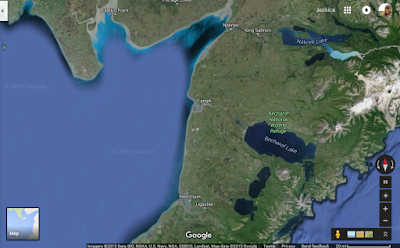The results of my investigation are scientific and anecdotal. The former is more limited. In science you must have a way to test your hypothesis (in this case, that animals can sense beauty), but unfortunately we do not as of yet have a way to directly assess an animal's feelings on say, a colorful sunset. Another important aspect of good science is objectivity, and it is difficult to maintain objectivity when studying something so subjective. However, neuroscience has made significant strides in the field of animal cognition. In order to understand, we must broaden our focus to emotions in general, and step back far into our evolutionary history. Emotions help us to survive; fear tells us to run from predators and love tells us to care for our young. Dr. Jaak Panksepp, an pioneer and expert in this field, says that "Every good feeling tells you that you are on the probable path of survival. Every bad feeling anticipates the probability of destruction." Dr. Panksepp and colleagues mapped out seven core emotional systems in our and many other species' brains. He calls these SEEKING (helps with finding food), RAGE (helps us get our way), FEAR (helps avoid harm), LUST (helps find mates), CARE (essential for raising young), SADNESS/PANIC (helps form and maintain social bonds by trying to avoid loneliness and separation), and PLAY (teaches us to socialize and about our environment). Panksepp believes we are inherently optimistic, because positive emotions motivate us to survive.
Beauty inspires positive emotions, and is defined as the quality of being pleasing, especially to the eye. The cliche we all know is "Beauty is in the eye of the beholder." If beauty is the quality of being pleasing, animals certainly find things pleasing. "Why wouldn't they? Pleasure is nature's way of saying 'Good-behavior!' It encourages us to do it again", says Dr. Jonathan Balcombe, an animal behaviorist with the Humane Society. He cites examples of animals playing and eating, and cliff-diving monkeys, (for which there is really no other explanation than they were having fun- see video below).
Video from YouTube.
Most obvious of what is pleasing to animals' eyes are members of the opposite sex. Males of many species show their strength and health (and hence their desirability as a mate), through bright color and elaborate ornaments. The more aesthetically pleasing the male is, the better a mate he would make. Females know this; in this way they arguably recognize beauty. Birds have taken this to an extreme level. One of the most well-known examples is the Peacock. One of my favorites is the Northern Cardinal; the red plumage and orange bill in males is attained from carotenoids in the bird's diet. In other words, you can see how well a male cardinal is eating by his color, and so can she. Perhaps an even more interesting example is found in the Vogelkop Bowerbird. The male of this species is not colorful, however, he spends years building an ornate, colorful, house-like structure, called a Bower, to attract a mate. What is even more intriguing is that each male prefers different materials and colors, suggesting that each has his own opinion on what is aesthetically pleasing. For a truly amazing video, please see below.
Picture from Google Images.
Picture from Google Images.
Video from BBC
Animals not only have an eye for color, but an ear for music. Again, this often comes back to sex. The Northern Mockingbird, and many other birds, mimics the songs and calls of other species. An impressive repertoire is attractive. Humpback Whale males sing complex songs, the purposes of which are still not understood. What is known is that these songs evolve over time and that different songs are sang in different areas; a musical culture.
Outside of their natural environments, animals display more behaviors that denote the possibility of other species having a sense of beauty. Specifically, I think of 'Art' done by animals in captivity. Chimpanzees, elephants, dolphins, and other animals in zoos will draw and paint when given he proper utensils and pads. Congo, a chimpanzee, was one of the first animals given such an opportunity. Although his drawings were what we might consider 'Abstract', zoologists noted that he seemed to have intention, and he would decisively begin and finish his works. If I asked a number of individuals what are some of the first nouns they think of when given the adjective "beautiful", I think most would say the noun form of art among other words. Art is a common avenue for humans to express what we perceive as beautiful. Perhaps these zoo animals do the same. Below is a painting done by an elephant. It appears to be flowers, which we find beautiful and are also the subject of many paintings done by humans.
Picture from BBC
In conclusion, by certain definitions animals do interpret aspects of their environment as beautiful, and animals in captivity have created artwork (which humans use as an avenue for expressing what they find beautiful). I don't know whether I or other scientists will ever be able to answer the question "Do bears find the Northern Lights beautiful?". I can say, however, that I have watched bears gaze contemplatively at their surroundings, and I've watched many sunsets with my dogs. Animals definitely have great capacity for emotions. As 2015 draws to an end, we can all make the New Year's Resolution of vowing to be empathetic towards members of other species as well as our own. We have similar neural pathways and we share the same planet. Merry Christmas and a Happy New Year to everyone reading!
Video by WWF.
Sources:
On Panksepp and the seven core emotional systems:
- http://wsm.wsu.edu/s/index.php?id=1037
- http://discovermagazine.com/2012/may/11-jaak-panksepp-rat-tickler-found-humans-7-primal-emotions
On Balcombe and pleasure:
- http://www.huffingtonpost.com/2014/04/08/animals-feel-pleasure_n_5110979.html

























































